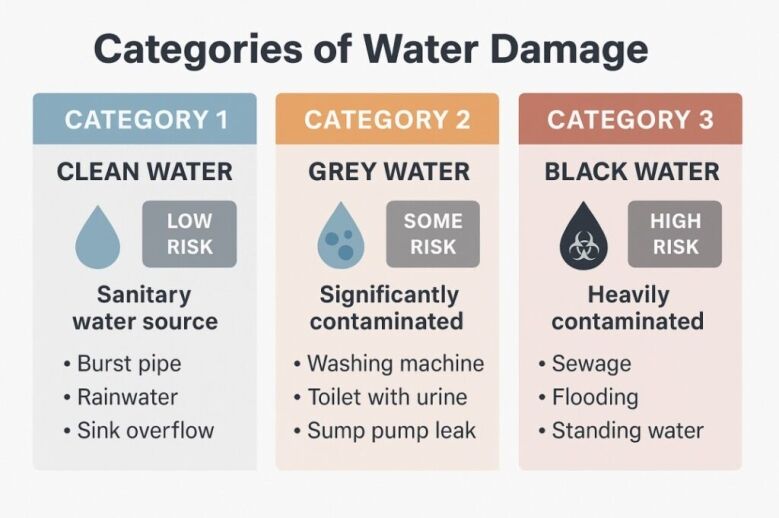Insights from the ANSI/IICRC S500 Standard
Not all water damage is the same.
Whether a burst pipe floods your living room or a storm sends dirty floodwater through your home, the type of water involved determines the level of risk, the cleaning process, and even your insurance coverage.
The ANSI/IICRC S500 Standard for Professional Water Damage Restoration—the industry’s global benchmark—classifies water intrusions into three categories.
Understanding these categories is essential for property owners, managers, and insurers to ensure proper restoration and health protection.
What Are the Water Damage Categories?
The S500 defines categories based on contamination levels and potential health risks.
This classification guides restoration professionals in selecting the right cleaning methods, protective equipment, and disposal protocols.
Category 1: Clean Water
Definition:
Water from a sanitary source that poses no significant risk to occupants if addressed quickly.
Common Sources:
-
Burst potable-water pipes or supply lines
-
Overflow from sinks or bathtubs with no contaminants
-
Rainwater that has not touched soil or building contaminants
Risks:
While Category 1 is the least hazardous, it can rapidly degrade into Category 2 if left untreated for more than 24–48 hours.
Microbial growth begins quickly, and hidden moisture in carpet underlay, wall cavities, or subfloors can lead to mould and structural decay.
Restoration Steps:
-
Rapid extraction and drying
-
Minimal cleaning and disinfection
-
Moisture monitoring until “dry standard” levels are achieved
Category 2: Grey Water
Definition:
Water with significant contamination that may cause discomfort or illness if ingested or exposed to skin.
Common Sources:
-
Washing machine or dishwasher discharge
-
Aquarium leaks
-
Toilet bowl overflow without faeces
-
Sump pump failures
Risks:
Grey water may contain bacteria, chemicals, or organic matter.
It requires special cleaning agents, removal of porous materials (e.g., wet carpet padding), and the use of personal protective equipment (PPE).
Restoration Steps:
-
Extraction and disposal of unsalvageable materials
-
Application of antimicrobial treatments
-
Thorough drying and moisture verification
Category 3: Black Water
Definition:
Water that is grossly contaminated and poses serious health risks, including disease and infection.
Common Sources:
-
Sewage backups or toilet overflow containing faeces
-
Rising floodwater from rivers, creeks, or storm surges
-
Intrusions involving chemical spills or stagnant water
Risks:
Black water contains pathogens, toxic chemicals, and heavy organic loads.
Exposure can lead to serious illness and requires strict containment and disposal procedures.
Restoration Steps:
-
Full containment of affected areas
-
Removal of all porous materials (carpet, drywall, insulation)
-
Professional cleaning, disinfection, and drying per S500 guidelines
-
Clearance testing to verify safety before reoccupation
Why Proper Classification Matters
Correctly identifying the category is critical for:
-
Health & Safety – Prevents exposure to harmful bacteria and mould.
-
Insurance Claims – Insurers often require S500-compliant documentation to approve coverage.
-
Cost Control – Early action can prevent a clean-water event from escalating to a hazardous black-water cleanup.
Reztor’s S500-Compliant Process
At Reztor Restoration, our IICRC-certified technicians follow a strict assessment protocol:
-
On-Site Inspection – Moisture mapping and contamination testing.
-
Category Classification – Accurate identification according to S500 standards.
-
Custom Restoration Plan – Equipment, chemicals, and containment tailored to the category.
-
Monitoring & Documentation – Daily reports to meet insurer requirements and ensure full structural drying.
This standards-driven approach protects both property value and occupant health, while giving insurers the confidence to process claims without dispute.
Key Takeaways
-
Category 1 is clean water but can quickly worsen if left untreated.
-
Category 2 requires professional cleaning and disinfection.
-
Category 3 demands strict containment and full material removal.
-
Prompt action is essential to prevent escalation and protect health.
Need Immediate Help?
If you’ve experienced any type of water intrusion, every hour counts.
Call Reztor Restoration’s 24/7 emergency team to ensure your property is restored to ANSI/IICRC S500 standards.
Contact Us Now
1800 739 867
